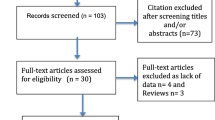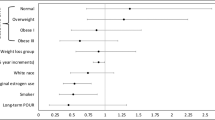Abstract
This study assessed the effect of moderate weight loss in obese women with urodynamically proven urinary incontinence using the International Consultation on Incontinence recommended outcome measures. Sixty-four incontinent women were offered a weight reduction programme with a target loss of 5–10%. This included a low-calorie diet and exercise. An anti-obesity drug (Orlistat) was offered to those who failed to achieve their target. Forty-two (65%) achieved the target weight loss and had significant reduction in body mass index and girth. Weight loss was associated with significant reduction in pad test loss (median difference, 19 g; 95% confidence interval, 13–28 g; p < 0.001). There was also a clinical and statistically significant improvement in quality of life measures. These results suggest that weight reduction of 5% of initial body weight can improve urinary incontinence severity and its effects on quality of life in obese women.


Similar content being viewed by others
Abbreviations
- UI:
-
urinary incontinence
- BMI:
-
body mass index
- QoL:
-
quality of life
- LCD:
-
low calorie diet
- KHQ:
-
Kings Health Questionnaire
- FVC:
-
frequency volume chart
- BIA:
-
bioelectric impedance analysis
- USI:
-
urodynamic stress incontinence
- DOI:
-
detrusor overactivity incontinence
References
Department of Health (2002) Health Survey for England
Flegal KM, Carroll MD, Ogden CL, Johnson CL (2002) Prevalence and trends in obesity among US adults, 1999-2000. JAMA 288:1723–1727
Hunskaar S, Burgio K, Clark A, Lapita MC, Nelson R, Sillen U et al (2005) Epidemiology of Urinary and faecal incontinence and pelvic organ prolapse. In: Abrams P, Cardozo L, Khoury S, Wein A (eds) Incontinence. Third International Consultation on Incontinence, 3rd edn., pp 255–312
Olsen AL, Smith VJ, Bergstrom JO, Colling JC, Clark AL (1997) Epidemiology of surgically managed pelvic organ prolapse and urinary incontinence. Obstet Gynecol 89:501–506
Bump RC, Sugerman HJ, Fantl JA, McClish DK (1992) Obesity and lower urinary tract function in women: effect of surgically induced weight loss. Am J Obstet Gynecol 167:392–397
Deitel M, Stone E, Kassam HA, Wilk EJ, Sutherland DJ (1988) Gynecologic-obstetric changes after loss of massive excess weight following bariatric surgery. J Am Coll Nutr 7:147–153
Subak L, Johnson CL, Whitcomb D, Boban J, Brown JS (2002) Does weight loss improve incontinence in moderately obese women? Int Urogynecol J 13:40–43
Subak LL, Whitcomb E, Shen H, Saxton J, Vittinghoff E, Brown JS (2005) Weight loss: a novel and effective treatment for urinary incontinence. J Urol 174:190–195
Burgio KL, Richter HE, Clements RH, Redden DT, Goode PS (2007) Changes in urinary and fecal incontinence symptoms with weight loss surgery in morbidly obese women. Obstet Gynecol 110:1034–40
Brieger G, Korda A (1992) The effect of obesity on the outcome of successful surgery for genuine stress incontinence. Aust N Z J Obstet Gynaecol 32:71–72
Wilson PD, Berghamans B, Hagen S, Hay-Smith J, Moorre K, Nygaard I et al (2005) Adult Conservative Management. In: Abrams P, Cardozo L, Khoury S, Wein A (eds) Incontinence. Third Intenational Consultation on Incontinence, 3rd edn., pp 855–964
Lose G, Fantl JA, Victor A, Walter S, Wells TL, Wyman J, Mattiasson A (2001) Outcome measures for research in adult women with symptoms of lower urinary tract dysfunction Standardization Committee of the International Continence Society. Acta Obstet Gynecol Scand 80:981–985
Abrams P, Andersson KE, Brubaker L, Cardozo L, Cottenden A, Denis L et al (2005) Evaluation and treatment of urinary incontinence, pelvic organ prolapse and faecal incontinence. In: Abrams P, Cardozo L, Khoury S, Wein A (eds) Incontinence. Third International Consultation on Incontinence, 3rd edn., pp 1589–1630
Roethlisberger F (1941) The Hawthorne experiments. In: Classics of organizational behaviour. Interstate printers, Danville, IL
Lord J, Thomas R, Fox B, Acharya U, Wilkin T (2006) The effect of metformin on fat distribution and the metabolic syndrome in women with polycystic ovary syndrome-a randomised, double-blind, placebo-controlled trial. BJOG 11:3817–824
Lukaski HC (1987) Methods for assessment of human body composition: traditional and new. Am J Clin Nutrition 46:537–556
Schaer GN, Koechli OR, Schuessler B, Haller U (1996) Perineal ultrasound: determination of reliable examination procedures. Ultrasound Obstet Gynecol 7:347–352
King JK, Freeman RM (1998) Is antenatal bladder neck mobility a risk factor for postpartum stress incontinence? BJOG 105:1300–1307
Isherwood PJ, Rane A (2000) Comparative assessment of pelvic floor strength using a perineometer and digital examination. BJOG 107:1007–1011
Foreyt JP, Goodrick GK (1991) Factors common to successful therapy for the obese patient. Med Sci Sports Exerc 23:292–297
Stevens N, Sykes K (1996) Aerobic fitness testing: an update. Occup Health (Lond) 48:436–438
O’Sullivan R, Karantanis E, Stevermuer TL, Allen W, Moore KH (2004) Definition of mild, moderate and severe incontinence on the 24-hour pad test. BJOG 111:859–862
Armitage P, Berry G (1994) Statistical methods in medical research. Blackwell Science, London
Kelleher CJ, Pleil AM, Reese PR, Burgess SM, Brodish PH (2004) How much is enough and who says so? BJOG 111:605–612
World Health Organization (1997) Consultation on Obesity: preventing and managing the global epidemic. WHO Technical Report Series 894
National Institute for Health and Clinical Excellence (2006) Obesity: the prevention, identification, assessment and management of overweight and obesity in adults and children. Clinical guideline 43
Bidmead J, Cardozo L, McLellan A, Khullar V, Kelleher C (2001) A comparison of the objective and subjective outcomes of colposuspension for stress incontinence in women. BJOG 108:408–413
Pi-Sunyer FX (1996) A review of long-term studies evaluating the efficacy of weight loss in ameliorating disorders associated with obesity. Clin Ther 18:1006–1035
Lambert DM, Marceau S, Forse RA (2005) Intra-abdominal pressure in the morbidly obese. Obes Surg 15:1225–1232
Lam J, Hartwell S, Jekel J (1994) I prayed real hard, so I know I’ll get in: living with randomization in social research, critically evaluating the role of the randomized experiments. New Dir Progr Eval 63:55–66
Conflicts of interest
None.
Author information
Authors and Affiliations
Corresponding author
Rights and permissions
About this article
Cite this article
Auwad, W., Steggles, P., Bombieri, L. et al. Moderate weight loss in obese women with urinary incontinence: a prospective longitudinal study. Int Urogynecol J 19, 1251–1259 (2008). https://doi.org/10.1007/s00192-008-0616-9
Received:
Accepted:
Published:
Issue Date:
DOI: https://doi.org/10.1007/s00192-008-0616-9




